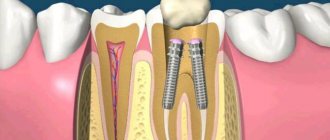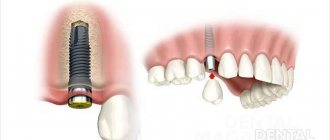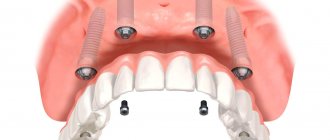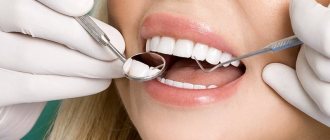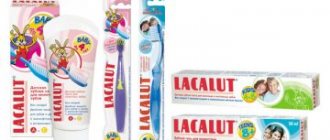Today, dozens of methods have been developed to restore and correct teeth, each of which is designed to quickly and painlessly solve a specific clinical problem. In cases of carious destruction, inlays have proven themselves to be the best, and if the tooth lacks support, pins come to the rescue.
The installation of a pin during dental prosthetics is carried out as follows: one end of the rod is screwed into the root canal, and a new beautiful tooth is attached to the other.
Dental pin: what is it, its advantages and disadvantages
What is a dental post? This is a specialized dental structure that looks like a rod. It is installed into the tooth root as a support for a filling or crown. Installation of a pin is only possible if the tooth has a healthy root. As a rule, this design is used if the tooth is badly damaged and thin walls remain.
Advantages:
- reducing the load on the tooth root;
- the ability to restore the crown in just one visit to the dentist;
- ease of installation;
- high level of aesthetics of the future artificial tooth;
- relatively low cost.
Flaws:
- instability under heavy chewing loads;
- there is a risk of damage to the root walls;
- allergic reactions and the development of secondary caries are possible;
- metal rods can only be removed together with the tooth.
To successfully install the pin, the following conditions will need to be met:
- the length of the rod must be at least 2/3 of the length of the dental canal;
- the size of the rim of healthy tooth tissue is at least 2 mm;
- root canal treatment was carried out with high quality;
- the root canal was given a cylindrical or conical shape.
Why are anchor pins needed in dentistry?
If a tooth is more than 30% damaged, it can be filled. But such a filling will not last long - exactly until the first serious test, for example, eating hard food.
Imagine that you are biting into a hard apple or a cracker, and at this time you can hear your tooth crunching. It's an unpleasant situation, isn't it? To prevent this from happening, pins are used.
The rod retainer ensures uniform distribution of chewing loads on hard dental tissues. It restores the functionality of a weak, dilapidated tooth and allows you to eat fully, including roughage in the menu.
Clinical case No. 1: tooth destroyed by 30-50%
The best option is to build up the crown with a photopolymer composite. The doctor drills out the carious tissue, removes the pulp (dental nerve), and then cleans the canals and treats them with an antiseptic. A pin is fixed into the dental canal, and a crown is formed around it by layer-by-layer application of the composite. Each layer is illuminated with a halogen lamp.
Clinical case No. 2: tooth destroyed by 50-90%
A rod with a supporting element (shoulder) for the crown is used. First, the doctor fixes the pin and then takes impressions of the patient’s teeth. Based on them, an individual crown is made in a dental laboratory. In about a week, your prosthesis will be ready, the doctor will fix it with cement-glue.
How long does it take to install a pin and how painful is this process?
The duration of the procedure directly depends on the initial condition of the oral cavity. If there are no problems, the pin is placed in one visit to the dentist. If periodontal diseases and other pathologies are present, a pin will be installed in the tooth root only after they have been eliminated.
Since the doctor touches soft tissue during the implantation of the supporting element, the procedure is often accompanied by painful sensations. The occurrence of pain after nerve removal is a natural process. But if a long-depulped tooth hurts, it is possible that the rod has entered too deeply into the canal. X-rays will help identify the cause of the pain.
Advantages and disadvantages
Main advantages:
- they cannot be broken;
- affordable price;
- service life is about 10 years.
But many doctors believe that anchors are outdated and do not meet modern requirements.
Flaws:
- low connection strength;
- poor aesthetics - metal pins are not suitable for restoration of anterior teeth;
- high risk of root fracture when installing a metal rod;
- difficulties in removing the pin from the canal (if repeated endodontic treatment is required);
- metal corrosion may occur.
An alternative to anchor structures are flexible fiberglass pins, which are made from transparent glass fibers. They are considered more advanced and are indicated even for frontal teeth.
Indications and contraindications for installing pins
Indications:
- damage to the tooth crown by more than 50%;
- the need to create support for prostheses;
- tooth loss;
- weakening of the tooth due to dental diseases.
Contraindications:
- untreated caries;
- the presence of inflammatory processes in the area of the tooth root;
- root destruction;
- blood diseases;
- insufficient thickness of the root canal;
- the presence of caries and periodontal inflammation;
- granulomas, cysts;
- exacerbation of systemic diseases;
- pregnancy;
- allergy.
It is important to know. The choice of the most suitable type of pin is always up to the doctor. It is unacceptable to focus only on the cost of the dental structure.
Kinds
Anchor pins are made from platinum, palladium alloys, titanium or stainless steel. They also come in brass and gold plated.
The clamps vary in shape:
- conical;
- cylindrical;
- cylindrical-conical.
By installation method:
- Active.
They have a thread on the surface and are installed by screwing the root into the dentin (bone tissue). The method is not the safest, since perforation (damage) to the walls of the tooth root may occur during the installation process.
- Passive.
With a smooth surface, they are fixed only by a layer of cement. The method is considered more gentle.
In addition, each Komet, Dentsply Unimetric, etc.) produces pins in original designs and in various sizes. There are variations in length (S, M, L) and thickness (from 1 to 6 mm).
Pin Installation Procedure
How to install a pin in a tooth? The procedure occurs in several stages:
- Removal of all dental tissues affected by caries.
- Preparing the bed for the pin using a special reamer and calibration cutter.
- Root canal preparation.
- Fitting the rod to the tooth.
- Installation of the pin; dual-curing adhesive is used as a fixing element.
- Restoration work using a crown or prepared filling material.
The Saint-Dent Clinic in Moscow offers a wide range of dental services for adults and children. The current cost of services can be found here, the contact page is located here.
Cost of restoring a tooth with an anchor pin
- titanium pin - about 500 rubles;
- titanium with gold plated - about 800 rubles;
- tooth extension with photopolymer – from 2,500 rubles;
- metal-ceramic crown – from 10,000 rubles.
Installing an anchor pin makes it possible to re-mold the damaged tooth and preserve the remaining tissue. But is it better to choose a cheap metal rod or a more expensive fiberglass retainer? Only your attending physician can answer this question, having assessed all the nuances of the clinical picture.
If you are looking for a dentist or a suitable clinic, then use the search engine on our website.
Possible complications
- severe pain, swelling;
- root fracture;
- restoration chips;
- the occurrence of a local allergic reaction to the material from which the rod is made;
- development of the inflammatory process (stomatitis, periodontitis);
- cyst development;
- fistula formation;
- mechanical damage to the walls of the tooth, which can lead to perforation of the root canals;
- splinters from dental instruments getting into the root canal.
It is important to know. The most dangerous complication is rejection of the installed supporting element by the body. In this case, it must be completely removed from the oral cavity.
Fixing fiberglass pins
I want to offer you a technique for creating, individualizing and fixing fiberglass pins (stump inlay) directly at the workplace in a direct way.
This will make it possible to obtain a mechanically fitted polymer pin, reduce and actually level out the adhesive-composite stress of the ligament. Obtain a reliable adhesive connection.
Transluma pins (manufactured by Bisco) are excellent for these purposes (Fig. 3). This is an export version of radiopaque fiber pins specially developed by the company for the European and world markets. These pins are made from a homogeneous solid prestressed fiberglass (long-lasting cyclic loading), they are classified as light transmitting, they have a simple tapered design, and they come in 3 sizes (this is a very old advert).
What to do if a tooth with a pin hurts
In the first hours, rinsing the mouth with a soda solution (1 teaspoon of soda per glass of water) will help relieve toothache. A decoction of chamomile and sage has a similar effect. You can also take painkillers and apply ice to your cheek in the area where the pin was placed.
It is important to know. The occurrence of slight swelling and pain in the first days after installation of the pin is normal. But if these symptoms persist for a long time and the patient experiences an elevated body temperature, you should consult a dentist.
Procedure for caring for pinned teeth
In the postoperative period, patients are recommended:
- adhere to a gentle diet, give up alcohol, cigarettes and food that can injure the epithelial tissues of the oral cavity;
- provide thorough hygienic care of teeth and oral cavity;
- floss regularly;
- do not attempt to open bottles with your teeth, do not crack the shells of nuts or seeds;
- visit the dentist at least once every six months.
It is important to understand that the appearance of pain, swelling, hyperemia or inflammation of the gums in the area of the restored tooth may indicate the development of serious complications of the procedure. For this reason, identifying the symptoms described above is the basis for contacting doctors and receiving professional medical care.
The most common questions about pins and answers to them
Is it always possible to get by with a pin?
Unfortunately no. In case of significant tooth decay, when there is a risk of further destruction of the coronal part, dental prosthetics are recommended.
How to care for your teeth after having a pin installed?
For two weeks, it is not advisable to eat too hard food and use toothpicks. When brushing your teeth, you need to be as careful as possible so as not to injure your gums.
Is there an alternative to a dental post?
Yes, you can install a stump tab instead. This is a microprosthesis, the lower part of which is fixed into the root canals, and the upper part serves as a supporting element for an artificial crown.
Types of dental pins
Depending on the material used to create a dental device, pins are divided into two groups:
- metal (made from titanium, brass, palladium, stainless steel or gold alloys with impurities);
- non-metallic (made from fiberglass, ceramics or carbon fiber).
According to their shape, pin structures are divided into conical, cylindrical-conical, screw and cylindrical. In turn, according to the method of fixation, such devices are classified into:
- active (having a thread with which they are screwed into bone tissue);
- passive (fixed in the root canal using special cement).
The choice of one or another pin design is made taking into account:
- the degree of destruction of the tooth root, the thickness of its walls;
- degree of damage to the crown of the tooth;
- the planned load on the tooth after completion of its restoration;
- the patient's health and financial capabilities.
Indications and contraindications for the installation of dental pins
Indications for the installation of pin dental structures are:
- the presence of a need to create a strong support for removable and fixed dentures based on teeth that have undergone severe destruction;
- absence of a crown in the presence of a healthy root;
- there is a need to restore teeth whose crowns are more than half destroyed.
Meanwhile, the method of orthopedic treatment using pins also has several contraindications. Reasons for refusing to carry out such a procedure may be:
- blood diseases;
- pathologies in the functioning of the central nervous system;
- carious lesions of teeth;
- periodontal diseases;
- the presence of cystic formations and granulomas in the oral cavity;
- severe deformation of the root canals, their obstruction;
- the presence of signs indicating a superficial attitude of the patient towards compliance with oral hygiene requirements.
Care after installation
After the restoration, the specialist will definitely give detailed recommendations regarding care during rehabilitation and recovery. So, for about a week it is better to stop eating solid foods and using toothpicks.
In the future, care should be taken to treat the restored tooth, trying to protect it from excessive mechanical loads and traumatic factors. An important condition is responsible adherence to the rules of hygiene: regular brushing of teeth twice every day, rinsing the mouth after meals, systematic visits to the dentist for preventive examinations.
Proper dental hygiene is important to maintain your smile.
Alternative restoration options
Many dentists today try to avoid anchors because they now have more modern and reliable products at their disposal that do not have many of the disadvantages inherent in metal rods. The priority is ceramics for the front teeth, as well as fiberglass - a durable and fairly elastic material that can withstand high loads, but without compromising the aesthetic component. Among the advantages of fiberglass products are the following:
- no risk of allergies,
- simple and safe installation,
- preservation of the walls of the root canal in the long term,
- ease of removal of the structure, and the possibility of its return in place after treatment,
- the ability to achieve high aesthetics during restoration,
- strength and reliability.
Fiberglass pin makes it possible to achieve high aesthetics in prosthetics
“I had one of my front teeth restored, and the doctor immediately said that it would be better to use a fiberglass pin. It is ideal for the smile area, does not show through over time, and holds firmly. In my case, the result exceeded all my expectations - the tooth is exactly the same as all the others, I don’t notice any differences. About a year passed and no visible changes occurred. And I’ve never heard of an allergy to fiberglass...”
Olga, from correspondence on the woman.ru forum
Fiberglass is absolutely resistant to the aggressive external environment of the oral cavity. In addition, this is an excellent option if the restoration is carried out without the use of prosthetic products, namely with the help of composite materials - the fibers have a matte white color, so they will not show through the composite and thereby spoil the appearance of the smile. Installation is less traumatic, and the risk of root damage remains minimal.
Terms of use
Not every patient can receive a pin support. To securely hold the structure, two basic conditions must be met:
- the thickness of the root wall should not exceed two millimeters;
- if necessary, you can unseal the canal by 2/3 of its length (this situation arises if the roots have already been filled).
Contraindications to implantation are:
- very thin root walls;
- advanced inflammatory process;
- untreated granuloma, cyst;
- pregnancy;
- obstruction and severe tortuosity of the root mouth, the inability to carry out its high-quality processing.
